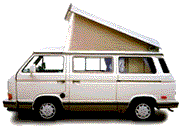Date: Tue, 15 Nov 2005 23:08:06 +0000
Reply-To: Robert Rountree <syncro87@HOTMAIL.COM>
Sender: Vanagon Mailing List <vanagon@gerry.vanagon.com>
From: Robert Rountree <syncro87@HOTMAIL.COM>
Subject: winter storage
Content-Type: text/plain; format=flowed
What I have learned from storing 4 vans over 37 winters,
in rural Ontario we have -35 winter lows and temperatures that for months
can never get above freezing.
1st find a place where your van will be out of the sun, (I have a north
covered car port spot) you could use the back (north side) of a building, or
behind a row of tall thick cedars (north side), or use a full thick fabric
cover. ... when left out in the sun, the interior fabric fades and weakens
from all the UV reflected off the snow. On a normal winter day, one moment
your vans at -20, the clouds clear, the sun warms the interior up to 60
inside, the clouds return, snap it's back to real cold. This is clearly
evident on vans stored outside by looking at their headliner, you'll see
they have bubbles or areas of separations from the vinyl covering on the
plywood ceiling. The different tension between the surfaces reeks havoc on
all kinds of things. When it warms up inside, the moisture is freed, then
refreeze, over and over... warm condensation forms up top and in door panels
and just keeps doing it's physical dance, from dew to crystal and back,
expanding and contracting.. ..The foam mattress up top gets funky, the fuzzy
fiberglass ceiling flocking can get mildews etc.
I make 4- mounds of gravel, in front of each tire. The tops of the mounds
are level to each other and about 4" high, I park up on top of those mounds,
then the van is level and above any freezing run off. This helps keep the
tires high and dry and stops water from getting into any cracks in my tires,
freezing and rusting the belts. If you have really nice tires and the sun
shines on them, do what serious RV'er do, cover them also. That stops the
hot & cool moisture cycles inside the tires and slows the dry rot.
I flush all drinking water and disconnect the pump (tube and electric in
line fuse) I shake the pump dry (I don't reconnect until spring) I leave a
note in the sink "NO water"... if your pump is in your tank, I guess you
could use RV -40 antifreeze ( wal-mart- rv dept), pour some in everything,
like sink drains, cooler drains, where ever water may stand. Make sure your
windshield washer tanks have lots of deep weather -40 antifreeze, not wimpy
summer bug cleaning stuff.
Remember... Rust never sleeps..
I have my full underside oil sprayed. (OilTech)
plus I spot, shoot ANY rust I see in the engine compartment and around with
Rust Check spray (tan-can, the thick stuff)
I remove my Aux. Battery and put it in my warm shop.
I disconnect my main battery ground.
I then bring out my charger a few times over the winter on warmer days and
top the battery up.
If I could get a better shot at the sun, I might get a small solar charger
panel on the car port roof.
I have the gas tank completely full, so there is no space for condensations
to form on the inside walls and cause rust.
I go thru my cabinets, drawer, glovebox etc. and remove Anything that will
freeze/expand.
I bring all my CD's, bedding, pillows etc. inside.
I remove all but one flashlight, all batteries, lotions, cream, jellies and
mechanical pleasure devices.
I don't leave dry pet food, or anything that can be eaten by a mouse.
I use synthetic oil so my engine always has a thin layer covering every part
inside. Even thought I have a VW block heater and it takes 2-3 hrs on a
normal winter day to warm the oil enough to turn the engine over. I don't
run my engines in the winter any more. It just causes to much condensation
inside the engine after you turn it off. If I need to drive for a few hours
it would heat off some. But unless I'm going south and I can get a clear
shot at dry roads. I don't drive at all on salty winter roads.
She's sleeping right now... just outside my bedroom window.
Dreaming of roads to come.
On the North side of the house just below the North star... that's why she's
called
Cynosure
RR
| 
